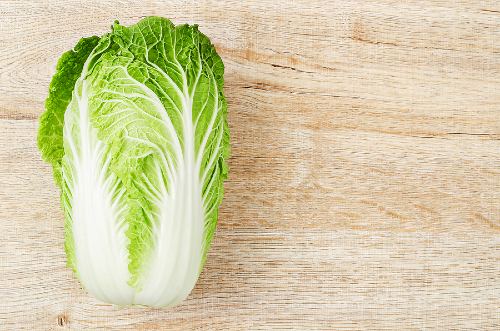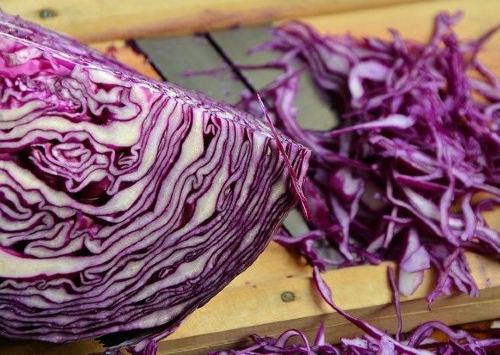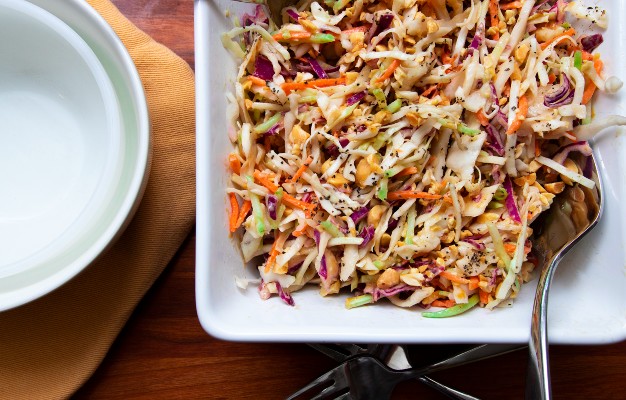Cabbage is the next featured vegetable in our “What’s In Season?” series!
From the different ways that it can be prepared to the nutrients that it contains, this veggie is one that you want to keep on your menu.
What sets cabbage apart?
Here at UGA SNAP-Ed, we think cabbage doesn’t get talked about enough. Cabbage belongs to a subgroup of vegetables called other vegetables known for the variety of nutrients that they offer. More fun facts about cabbage include:
- Cabbage comes in a variety of colors including green, white, and purple/red. [1]
- There are two major types of cabbage. The standard round head cabbage is most commonly seen in grocery stores and is shown in the photo above. The Chinese cabbage (seen in the photo below) has a more oval shape with thinner leaves. [2]
- Cabbage is an excellent source of Vitamin K and Vitamin C. [3] Vitamin K is important for bone and heart health, while Vitamin C keeps our immune system strong.
- Cabbage also contains fiber to aid in digestive health. [3] Other foods high in fiber are apples, quinoa, beans, and broccoli!
- Did you know that sauerkraut is fermented cabbage? Click here to learn how you can make this shelf-stable condiment at home!

Harvested in Georgia
Cabbage is a cold-weather crop that is normally harvested in the spring and the fall. Last year, shipments of cabbage in Georgia totaled 61.5 million pounds! [1]
You can plant cabbage in a variety of ways. The first way is by planting a seed directly into the ground. You can also grow a seed in a small pot indoors until it becomes a plant and then transplant it into the ground. [2] For more information on how to properly plant and look after your cabbage, check out this UGA Cooperative Extension resource.
Cabbage is 92% water. [3] While this means that it is a great source of water to include in your diet, it also means that cabbage needs a lot of water in order to grow. When it is not raining, cabbage plants need about 1-2 inches of water per week. [2]
You will know your cabbage is ready to be picked when it is full-size and firm to the touch. A head of fresh cabbage can be stored in a refrigerator for up to four months! [2] So don’t worry if you buy it and can’t find a use for it for a few weeks.
Like most vegetables, you can find cabbage in the produce section of your local grocery store year-round. However, if you are interested in purchasing locally grown produce, you can look for fresh cabbage from January to May and October through December. Georgia Grown even has a map that can show you where cabbage farmers are located throughout the state! Click here to find one near you to support your local economy.
For more information on when to buy produce when it is in season, check out our “What’s In Season in Georgia” chart.

Cabbage Recipes
Cabbage can be prepared in a variety of ways like steaming, boiling, stewing, and stir-frying. The leaves of the plant are also a great, crisp component for a salad. Here are some of our favorite ways to incorporate this vegetable into meals:
- Slaw is a popular way to use fresh cabbage. Try our Tri-Color Slaw with Peanuts for a southern twist on a classic. For more delicious slaw recipes, click here!
- This Ramen Pasta Salad features a crunch from the fresh cabbage and is the perfect simple recipe for a quick dinner at home.
- Cabbage is a great vegetable to stir-fry because it keeps its shape and crunch well. This Stir-Fry Cabbage recipe can make a light and simple side to any meal.

We hope this blog gave you a few new ideas on how you can include this versatile vegetable in your future meals and maybe even your garden! Check back with us next month for our next blog in the “What’s In Season?” series.
Written by Darci Bell, RDN, LD | Edited by Leslie Davis, RDN, LD, CDCES, and the Nutrition Team
Posted: March 14, 2022